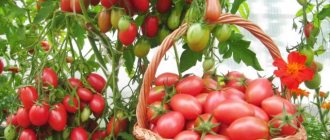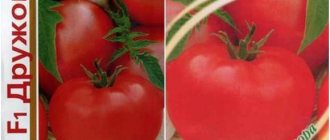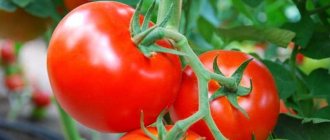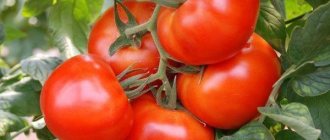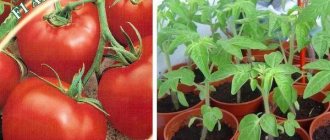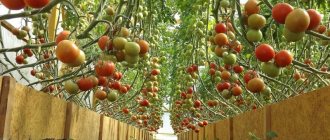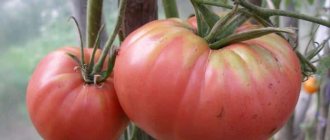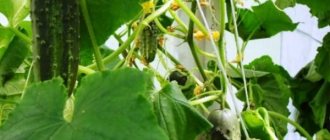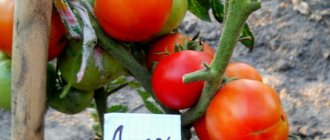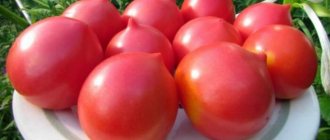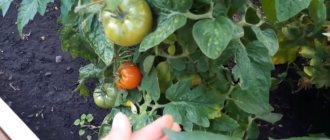Fungal (infectious) diseases of tomatoes
They arise as a result of infection of tomatoes by pathogenic fungi. They tend to reproduce quickly immediately after the plant is damaged, so action should be taken immediately. Appears on seeds and adult plants.
The situation is aggravated by weather conditions: sudden temperature changes, dampness, wind, as well as improper care.
It is better to prevent tomatoes from being affected by this fungus, because it is almost impossible to cure. The best option is to take preventive measures.
Late blight of tomatoes
The second name is brown rot, because the lesion contributes to the appearance of brown spots, which over time spread throughout the entire leaf blade. Pathogen – Phytophthora parasitica, Phytophthora capsici, Phytophthora dreshsleri. The damage begins from the roots, gradually moving upward.
The photo shows late blight of tomato
The main sign of late blight in tomatoes is the appearance of brown, watery spots that dry out over time
. The color of the plant's vascular system changes. It is advisable to treat with chemicals only at the initial stages of late blight.
Tomato varieties resistant to late blight
- Antyufey,
- Buvena,
- Galant,
- Grandma's gift,
- Entertainer,
- Truffle yellow,
- Green honey,
- golden canary,
- Indira,
- Lady fingers,
- Primabella', 'Primavera' or 'Resi',
- Yellow Submarine,
- Red Arrow F1,
- Black Russian.
Tomato varieties have weak resistance to late blight:
- Bull's heart
- Village F1
- Irishka F1,
- Countryman.
Tomato varieties resistant to late blight
Alternaria stem cancer
The common name is “dry rot” of tomatoes.
Occurs as a result of damage to Alternaria alternate f. sp. Lycopersici. Spreads quickly in damp, high humidity conditions. The fungus penetrates through damage to the stem. For example, through microcracks formed during pinching. There is no cure for Alternaria cancer. The only prevention is to plant varieties and hybrids of tomatoes with high immunity.
.
Pictured is Alternaria tomato blight
When infected by the fungus, dark brown spots appear, gradually occupying the entire stem. The result is death. First, small rust-colored specks appear on the foliage. The second sign of the presence of the disease is curling of the leaves. Affected fruits are not suitable for food.
Tomato varieties resistant to Alternaria
- F1 debut,
- Tomato Nina
- Diva F1
- Lyubasha.
How to deal with tomato Alternaria blight?
You can carry out preventive spraying of tomatoes against Alternaria with the fungicide KVADRIS 0.8–1.0 l/ha. In open ground it can be used in - REVUS TOP, 0.5–0.6 l/ha, or SKOR KE 0.4–0.5 l/ha.
Tomato anthracnose (spot rot, black spot rot)
The disease is caused by pathogens Colletotrichum coccodes, Colletotrichum dematium, Colletotrichum gloeosporioides, etc. Favorable conditions for the occurrence of Alternaria tomato blight are warm temperatures and high humidity
. Acidic soil, depleted in potassium and phosphorus, also contributes to the development of the disease.
Reference!
The fungi are carried by infected seeds and remaining parts of diseased plants.
The insidiousness of anthracnose is that it most often affects green tomato fruits, and the disease manifests itself when fully ripe.
Pictured is tomato anthracnose
The fruits look as if they have been squeezed. These areas become dark due to the accumulation of blackheads. Brown spots with black dots also form on the root system. To save the bushes, you will need to treat the tomatoes with fungicides. The sooner the treatment is carried out, the better.
Cercospora blight of tomatoes
Pseudocercospora fuligena develops in warm conditions with high humidity. It is carried by drops of water, wind, and garden tools. Yellowish spots form at the top, gradually increasing in size. Many fungal spores resembling mold appear at the bottom of the leaf. It is necessary to begin timely treatment to prevent necrosis. Treatment is carried out with fungicides.
Cercospora blight resistant tomato varieties
- Afen F1;
- Bull's Heart;
- Florentina F1.
Pictured is cercospora blight of tomato
Root suberization or “root fever” of tomatoes
Pyrenochaeta lycopersici attacks the root system of plantings. The infected plant appears limp. The leaves begin to drop and growth stops. Small light brown spots in the shape of an ellipse form on the roots. Then larger roots are affected.
The fungus can remain in the soil for several years.
It's dangerous not only for tomatoes. The best remedy is to treat the soil for preventive purposes and treat the seeds before sowing.
“Black leg” of tomatoes or damping off
A terrible disease of tomato culture that cannot be treated. Black leg occurs in tomatoes as a result of damage by mold fungi Pythium and Phytophtora, which live on the surface of the soil and consume organic matter. When there is not enough food, the roots of the plantings begin to be eaten. For the most part, greenhouse seedlings begin to hurt.
The photo shows a black tomato leg
After damage, plant tissue softens at the base of the stem, where brown or black rot appears. The leaves are falling. Preventive measures in the form of soil treatment are effective.
Tomato stem rot
Didymella lycopersici primarily affects old plantings. Phosphorus and nitrogen deficiency increases the likelihood of various tomato varieties becoming infected with stem rot. The leaves are affected, and later the stem and fruits.
Black ulcers resembling concentric circles form on the fruits. It's the same on the foliage. To avoid disease, it is necessary to constantly inspect the plantings, treat them with fungicides, and enrich the soil with vitamins and minerals.
Brown spot
Alternaria solani attacks all parts of tomatoes. The most initial signs are the formation of dark brown spots on old foliage. Black sores appear on the stems. The fungus multiplies especially actively at elevated temperatures and air humidity. Treatment is possible at the initial stage through treatment with fungicides.
Tomato fusarium (or fusarium wilt)
Fusarium usually refers to several diseases: wilting and rot of the root collar and roots caused by Fusarium oxyspoum and Fusarium solani. A favorable environment for fungal growth is high temperature and humidity.
There are several ways of spread: through equipment, insects, raindrops.
Tomato varieties resistant to fusarium
- Tomato Jackpot F1,
- Snow leopard F1,
- Chepetsky F1,
- Greek F1,
- F1 debut,
- Red Arrow F1,
- Diabolik F1,
- Sweet fountain F1,
- Stone Flower F1.
The photo shows fusarium blight on tomato
The pathogen poses the greatest danger during fruit ripening. Yellowness appears on the foliage of tomatoes, and the leaves themselves curl. As the infection spreads, the vascular system turns black. The root system also turns black. The disease cannot be treated, so you should try to choose tomato varieties that are resistant to fusarium.
How to cure Fusarium
Gray spot of tomato leaves
Damage to Stemphylium solani, Stemphylium lycopersici, Stemphylium botryosum f. sp. Lycopersici causes this disease. They are considered weak pathogenic microorganisms. However, this is not a reason to consider them not dangerous at all. Only affects foliage.
First, brown spots appear on the leaves of tomatoes, over time they increase in size and become gray.
Drying and cracking begins. Hot and rainy weather and prolonged absence of precipitation, temperature changes at night and during the day are favorable conditions for the spread of the fungus. Gray spot in tomatoes is treated with fungicides
.
Tomato varieties resistant to gray spot
- F1 debut,
- Diabolic F1.
Gray rot or botrytium blotch of tomatoes
Botrytis cinerea is a harmless and fairly common pathogen. For the fungus to begin to spread, the following conditions must exist: dampness and coolness, dense plantings.
Gray rot does not affect only the roots of tomatoes. Watery spots on the stems turn into mold. Infection with gray rot begins from the stalk. High temperature helps stop the development of fungus. Since the pathogen is not dangerous, the affected tomatoes are quite edible.
In the photo botrytis or gray rot of tomato
White rot, or sclerotinia on tomatoes
Sclerotinia sclerotiorum, Sclerotinia minor causes white rot. High air humidity, rain, dew, etc. - all these are suitable conditions for the development of the disease.
The base of the stem is the main place of concentration of the fungus. Gradually, the affected area is covered with white mold. Sclerotia then appear. They look like black peas or beads. Pathogens are able to maintain their vital activity in the soil for a long time, therefore, for treatment, the soil is treated with fungicides.
Control measures:
- High-quality disinfection of the greenhouse after crop rotation.
- Enrichment of the substrate with beneficial microbiota.
- Steaming the soil in greenhouses is the most effective method in combating the disease.
- Maintaining optimal temperature.
- Removing fruit drops from the greenhouse.
- The use of biological products based on Trichoderma.
- Spraying to combat gray rot with SWITCH®, VDG 0.8–1.0 kg/ha before harvesting fruits and before storing them also controls white rot.
Cladosporiosis of tomatoes or brown spot
Fulvia fulva is at its peak in July. Infection begins from the lower leaves. Favorable conditions are high humidity up to 90%, temperatures above +24 degrees above 0. It develops faster in a greenhouse: in a couple of days the pathogen can spread to all plants.
Cladosporiosis-resistant tomato varieties for greenhouses
Another name for the disease is brown (or olive) spot.
This fungal disease first affects the lower leaves of tomatoes. If measures are not taken in a timely manner, irreversible changes in their shape and color will quickly occur. The leaf blades will begin to turn yellow, dry out and die completely. Massive death of leaves leads to a deterioration in photosynthesis, and fruit yield is sharply reduced. More often, disease damage occurs in protected soil conditions in weakened plants. The causative agent of cladosporiosis is the very viable fungus Cladosporium fulvum (Cooke) Cifferri [syn.: Fulvia fulva]. Fungal spores can withstand both low and high temperatures for a long time.
Signs of illness
The first signs of ill health usually appear on the lower leaves. Yellow-brown, rounded spots appear on the upper side of the leaf blade.
On the lower part of the plate they have a light gray coating, which later becomes brownish-brownish with a velvety, denser structure. This is what conidial sporulation looks like, which later becomes a source of infection of other plants. The plates begin to wrinkle, curl, turn brown and dry out.
When appears
Most often, signs of the disease most actively appear during flowering and fruit formation; this occurs in the middle of the tomato growing season. By the second half of summer, the most favorable weather conditions for the development of the fungus have developed.
Plants are affected when they are exposed to conidia of the fungus, which reproduce asexually. Conidia are very light, their colonies resemble dust that settles on various objects, tools and structures. Therefore, infection can occur when working with contaminated tools.
Spores also scatter when watered with a stream of water, air, or when shaking the plants. The danger is that conidia can exist for a long time without host plants, overwinter in the soil and infect new seedlings in the spring. Even completely resistant varieties suffer from the effects of certain races of the pathogen. In a greenhouse, the mushroom Cladosporium fulvum can live up to 10 years.
The optimal temperature background for the development of tomato cladosporiosis is 20-28°C. The spread of the disease is facilitated by temperature changes in conditions of high humidity.
It is the most important factor for the life of the fungus. When the air humidity is more than 80%, the conidia of the fungus that have fallen on the leaves of the tomato come to life and germinate, and at 90-95% humidity the conditions become most favorable.
Attention! When humidity is below 70%, the development of the fungus is inhibited.
Drugs
- Broad-spectrum fungicides “Bravo” and “NeoTek” are used strictly in accordance with the manufacturer’s recommendations, as they are strong chemicals that can burn healthy leaves. Two treatments are carried out with an interval of 10-14 days in case of severe damage.
- Copper-containing preparations such as HOM (copper oxychloride) are very effective. Add 40 g of the product to 10 liters of water and spray the plants at the first signs of the disease.
- Polycarbacin (1 tbsp), colloidal sulfur (3 tbsp) and copper sulfate (1 tbsp). The preparations are thoroughly dissolved in 10 liters of water, a little liquid soap is added and used for spraying.
- Trichodermin. It is a biological agent, the active substance of which is the spores and mycelium of the fungus Trichoderma lignorum; it destroys the causative agent of cladosporiosis.
Other antifungal agents used against cladosporiosis: “Abiga-pik”, “Kuproksat”, “Poliram”, “Spartak”, “Fitosporin-M”, “Bogatyr extra”, “Bravo”.
Folk remedies
In the fight against plant diseases, gardeners successfully use various folk techniques. And although they do not always help with a serious level of damage, they are quite suitable as preventative agents and at the first signs of brown spot.
- Milk with iodine.
Used in proportion:
- milk - 500 ml;
- water −5 l;
- iodine - 15 drops.
It’s even better to take a milk solution without water. Then add 30-35 drops of iodine and 20-25 g of laundry soap to 1 liter of milk (for better adhesion of the solution).
- Potassium permanganate solution.
Plants can be sprayed with a weak pink solution of potassium permanganate in pure form or with garlic infusion and alternated with treatments with a decoction or infusion of ash.
- Decoction of wood ash.
Ash is used in a variety of ways; it is not only effective in fighting fungus, but also strengthens plant immunity and provides additional nutrition. For preparation:
- 300 g of ash is poured into 10 liters of water and boiled for 15 - 20 minutes;
- 3-4 kg of ash is poured with hot water (10 l), stirred periodically and left for 2-3 days. Drain off the light, settled part and dilute with water to 25-30 liters. For adhesion, add laundry soap (25-30 g).
- Milk serum.
The spray solution is prepared by adding 1 liter of serum to 10 liters of warm water and mixing thoroughly. The proportion of whey can be increased.
- Garlic tincture.
Make a remedy from 200-300 g of chopped garlic (or 0.5 kg of arrows) and 10 liters of water. The solution is infused in a warm place for 24 hours, the soil under the plants and the plants themselves are sprayed with it. To improve antifungal properties, add 2-3 g of potassium permanganate to the solution.
From the video you can learn how to prevent the appearance of cladosporiosis fungus and what to do if the plant is already infected.
For greenhouses, mainly tall hybrid varieties are used, such as:
- Pink Paradise F1 (mid-season, high-yielding variety; fruits are pink, tasty, dense, weighing 130-150 g);
- Marissa F1 (indeterminate bush type, the plant reaches a height of 3 m; the fruits are dense, uniform, with good taste, weighing up to 150 g; high yield);
- Spartak F1 (mid-season, high-yielding, very tasty variety for universal use; has proven itself well in open ground);
- Opera F1 (mid-season variety with high taste, universal use; fruits are small, red, about 100 g; yield per bush is about 5 kg).
We invite you to read: Dried figs: benefits and harm to the body
Among medium-sized figs we can recommend:
- Charisma F1. The variety is resistant to low temperatures, has high yield and good taste, universal fruits weighing 130-150 g.
For low shelters, a low-growing variety:
- Bohemia F1. Plant height is up to 80 cm. It is also successfully grown in open ground. Fruits weighing up to 150 g. The yield is small, about 4 kg/m², but it is compensated by high resistance to diseases, weather conditions and unpretentiousness.
Hybrid varieties are well adapted for open ground:
- Red Arrow F1 (early ripening, low-growing, very resistant variety, providing consistently high yields; the fruits are beautiful, even, tasty and aromatic);
- Our Masha F1 (mid-early variety with good taste, unpretentious, high-yielding; the fruits are fleshy, shelf-stable, weighing 150 - 180 g, ripen well when picked);
- Titanic F1 (mid-early, tall variety for greenhouses and open ground; the fruits are large, fleshy, with thin skin and good taste);
- Forsazh F1 (early ripening variety with excellent taste characteristics, compact bush shape and good yield; plum-shaped fruits weighing up to 150 g);
- Khrustik F1 (has an original yellow color, aromatic melon taste, dense crispy consistency; the fruits are perfectly stored).
For different territories, zoned varieties are selected that are more suitable for local conditions. For regions with unstable climates, resistant hybrids are well suited:
- Olya F1 (early ripening, high-yielding, salad variety; fruiting is friendly; resistant to diseases, low temperatures, heat);
- Ural F1 (large-fruited, medium-sized, cold-resistant variety; fruits weighing 300-350 g, with excellent taste);
- Vologda F1 (mid-season, cluster, resistant and unpretentious variety; the fruits are medium-sized, weighing about 100 g, but beautiful, smooth, have high marketability and taste; yield per bush is about 5 kg).
Other popular varieties resistant to cladosporiosis can be noted:
- Paradise Delight, Vezha, Funtik, Giant, Evpator, Raisa, Red Comet, Space Star F1, Lemon Boy F1.
The disease does not manifest itself in any way in the first half of summer, but by the second, like a slow fire, it gradually engulfs the entire plant infected with it.
The first symptoms appear on the leaves that form the lower floors of the plant “tree”, then the “starting fire” rises upward, gradually covering the entire green part of the plant.
Initially sparse, yellow-brown spots quickly become brown with a reddish tint and spread in breadth, inevitably involving the entire area of the leaf blades.
When greenhouse owners start talking about treating tomatoes for cladosporiosis, this means that they are already too late to save them - the process of development of the fungus has already begun, it is already penetrating the plant flesh with its hyphae, patiently waiting for the time to begin its “fruiting” - spore formation.
It should be understood that it is no longer possible to “pull out” the structures of the pathogen from the tissues of the host plant; the only thing that is more or less realistic is to restrain the development of the microorganism as much as possible, while helping the tomatoes to somehow “hold out” them until the harvest ripens.
The following can help in this matter:
- chemicals;
- recipes for traditional “herbal medicine”.
About chemical protection
When used, in addition to strict dosing according to the instructions (so as not to burn the leaves), it is necessary to re-spray the seedlings 14 days after the first.
Another promising remedy is a combination of three components:
- Polycarbacine;
- colloidal sulfur;
- copper sulfate.
For a 10-liter bucket of water you need:
- sulfur 3 tbsp. l.;
- Polycarbacin 1 tbsp. l.;
- vitriol also 1 tbsp. l.
As additional support, it is worth supplementing the composition with liquid soap. When spraying, pay special attention to the lower tiers of leaves and soil in order to disinfect it as much as possible.
Chemical treatment should precede the formation and ripening of tomato ovaries. Before this, maximum attention should be paid to:
- inspection of seedlings;
- tearing off excess lower leaves that prevent ventilation and drying of plants;
- spraying the crop with safe (due to its naturalness) means from the folk arsenal.
Bacterial diseases
Some bacteria are also dangerous for tomatoes. Their pathogenic effects resemble fungi. In the first stages, the disease is difficult to identify, which complicates the treatment process.
Bacterial cancer
Clavibacter michiganesis is the causative agent of bacterial cancer. The leaves of the affected plant begin to dry out, ulcers appear on the shoots, the vessels change color, mucus appears instead of juice, and ulcers form on the fruits. Favorable conditions – high humidity.
Plants can get sick at any stage of development. In some cases, planting material is infected. All that can be done to prevent the disease is to carry out pre-sowing treatment and choose resistant varieties and hybrids for planting.
Bacterial wilt (southern sclerotial wilt)
Burkholderia solanacerum develops mainly in the southern regions of the country
. This is favored by high temperatures up to +30 degrees above 0, humidity and soil composition. In addition to tomatoes, the bacterium is dangerous for another 200 types of plant crops.
The damage is directed to the root system, as a result of which the leaves begin to wilt. Chlorosis is not typical for this type of wilt.
Signs: appearance of mucus, change in color of the vascular system, appearance of voids in the stems. Infected plantings are destroyed, and the soil is treated with a solution of potassium permanganate for disinfection.
Tomato core necrosis
Pseudomonas corrugate – a bacterium that causes pith necrosis
. Conditions such as high air humidity, temperature changes, and increased nitrogen content in the soil are favorable for its spread. Develops faster in greenhouse conditions. Of all infected plants, about a third recover, since there are no means of treatment.
The damage begins from the roots, which leads to yellowness in the upper part of the bushes. Tomato stems become covered with black ulcers. As a result of blockage of blood vessels, bacterial rot is formed.
Bacterial leaf spot of tomatoes
Pseudomonas syringae is not too dangerous. It can be identified by brown spots on the foliage. Cold weather, high humidity, and sudden temperature changes are the most favorable conditions. The bacterium penetrates inside through microcracks in the roots and damage resulting from pinching. To eliminate bacterial spot disease in tomatoes, they are treated with copper sulfate.
Bacterial spotting of tomato fruits
Pseudomonas syringae affects all parts of plants: petioles, leaves, fruits. It is especially dangerous during the summer cold snap, as well as during sudden temperature changes.
Watering with too cold water can cause illness.
After infection, the first symptoms appear the next day
. In the early stages, Bordeaux mixture and copper sulfate can stop the course of the disease. And it is best to treat healthy plantings with them so that they do not get sick.
Bacterial spot
Symptoms of Xanthomonas vesicatoria can be seen on all parts of the plant. Watery spots appear on the foliage. After growth, the affected areas dry out and crack. Black cones with a white border appear on the tomatoes, with a depression in the center. Favorable time for the spread of bacterial spot on tomatoes: July - August.
Advice!
Proper watering is the basis for preventing this disease. At the initial stage of the disease, treatment with copper sulfate is effective.
Cladosporiosis or brown spot of tomatoes
Another name for the disease is brown (or olive) spot. This fungal disease first affects the lower leaves of tomatoes. If measures are not taken in a timely manner, irreversible changes in their shape and color will quickly occur. The leaf blades will begin to turn yellow, dry out and die completely. Massive death of leaves leads to a deterioration in photosynthesis, and fruit yield is sharply reduced. More often, disease damage occurs in protected soil conditions in weakened plants.
The causative agent of cladosporiosis is the very viable fungus Cladosporium fulvum (Cooke) Cifferri [syn.: Fulvia fulva]. Fungal spores can withstand both low and high temperatures for a long time.
Signs of illness
The first signs of ill health usually appear on the lower leaves. Yellow-brown, rounded spots appear on the upper side of the leaf blade.
On the lower part of the plate they have a light gray coating, which later becomes brownish-brownish with a velvety, denser structure. This is what conidial sporulation looks like, which later becomes a source of infection of other plants. The plates begin to wrinkle, curl, turn brown and dry out.
When appears
Most often, signs of the disease most actively appear during flowering and fruit formation; this occurs in the middle of the tomato growing season. By the second half of summer, the most favorable weather conditions for the development of the fungus have developed.
Distribution method
Plants are affected when they are exposed to conidia of the fungus, which reproduce asexually. Conidia are very light, their colonies resemble dust that settles on various objects, tools and structures. Therefore, infection can occur when working with contaminated tools.
Spores also scatter when watered with a stream of water, air, or when shaking the plants. The danger is that conidia can exist for a long time without host plants, overwinter in the soil and infect new seedlings in the spring. Even completely resistant varieties suffer from the effects of certain races of the pathogen. In a greenhouse, the mushroom Cladosporium fulvum can live up to 10 years.
Conditions for development
- Temperature.
The optimal temperature background for the development of tomato cladosporiosis is 20-28°C. The spread of the disease is facilitated by temperature changes in conditions of high humidity.
- Humidity.
It is the most important factor for the life of the fungus. When the air humidity is more than 80%, the conidia of the fungus that have fallen on the leaves of the tomato come to life and germinate, and at 90-95% humidity the conditions become most favorable.
Attention! When humidity is below 70%, the development of the fungus is inhibited.
Viral diseases of tomatoes
Viruses are often carried by insects, so it makes sense to fight even those that do not pose a threat to the tomato crop. These infections cannot be treated, and the bushes will have to be destroyed.
Tomato mosaic (or tobacco mosaic)
Tobacco mosaic virus is transmitted by aphids and thrips
.
Can be transmitted from other plants through cracks and wounds. Tomato mosaic disease is common, since a fifth of all diseased tomatoes are affected by this particular virus.
Mosaic features:
on the leaves there are either dark or light speckled spots, necrosis. Fruit ripening occurs unevenly. The pulp becomes brown. Tissue death occurs on some parts of the stems.
Prevention:
soil disinfection, seed treatment, compliance with care rules.
Tomato hybrids and varieties resistant to mosaic
- Groden F1,
- Tomato Jackpot F1
- Tsarin F1,
- Tomato Buyan yellow,
- Raisa F1,
- Irishka F1,
- Snow leopard F1,
- Nina,
- Tomato Persianovskiy F1,
- Stone Flower F1,
- Diva F1,
- Chepetsky F1,
- Minaret F1.
Tomato spotted wilt (bronzing)
Thrips, moving from one plant to another, carry the pathogen
. Light orange spots appear on the leaves, gradually darkening. The ends of the leaves die off, vertical stripes appear on the stems, and concentric circles of different colors appear on the tomatoes themselves.
Alfalfa mosaic
The carrier of the disease is aphid
. After damage, yellow spots, chlorosis and necrosis in the interveinal areas appear on tomato leaves. The color of the tissues becomes different, the tomatoes themselves become covered with brown ulcers. Symptoms do not appear immediately.
Mosaic of cucumbers
The diseases are dangerous for greenhouse plants. It is transmitted by aphids, and much less often through equipment. The leaves of the affected plant decrease in size, yellow mosaic-like spots appear, and necrosis appears on the stem and fruits.
Control measures: destruction of aphids, weeds, reduction in the number of ornamental plantings.
Tobacco engraving of tomato
This virus is also spread by aphids
. Infection can also occur from other nightshades and tobacco. Barely noticeable specks on the leaves can be a sign of disease. The fruits become smaller and the leaves become deformed. Difficult to treat.
Bushy dwarfism of tomatoes
Bushy dwarfism spreads through mechanical damage: wounds, microcracks, etc. Mostly young seedlings that develop very slowly are affected.
Signs: light stripes on the leaves, seedlings become soft and die, thin stems, few leaves.
Double streak of tomato
Tomato Mosaic Virus and Potato Virus X are the two main pathogens causing the disease
. The leaves begin to curl downwards, ulcers appear on the stem and petioles, and necrotic marks appear on the fruits. The virus is transmitted through equipment and drops of water.
Prevention: disinfection of garden tools.
Infectious chlorosis of tomato
Vector: whitefly
. Yellowish spots appear on both sides of the leaf blade. First, the old foliage is affected, and then the young leaves. Greenhouse tomatoes are most susceptible. The main measure to prevent the disease is the elimination of whiteflies.
tomato pillar
The disease is caused by a parasite that lives inside the cell, mycoplasma
.
Typical for the southern regions. They carry the cicada virus
. The virus is located in the roots of weeds and this is the main danger of this disease. After all, weeds cannot be completely eliminated.
Signs of stolbur in a tomato: a noticeable increase in buds, stalks, growth of side shoots, yellowness of the leaves, drying of the tips of the leaves, deformation of the shape of the tomatoes, no seeds in the seed chambers.
There are no tomato varieties that are completely resistant to stolbur, but there are those that are least at risk of this disease.
Tomato hybrids and varieties resistant to stolbur
- Sovereign F1;
- Premium F1;
- Elizabeth F1;
- East;
- Standard Alpatieva;
- Legionnaire F1.
The best prevention: weed and insect control.
Non-infectious diseases of tomato
In some cases, tomato diseases can occur due to hereditary disorders, non-compliance with plant care rules, unsuitable environmental growing conditions, or a deficiency of one or another element. Diseases caused by such causes are classified as non-infectious.
Autogenous necrosis of tomato
The cause of the disease autogenous necrosis is hereditary disorders
. The disease manifests itself best at elevated temperatures. You can notice initial symptoms on green fruits in the form of transparent or translucent oval-shaped spots.
Over time, they become yellowish-brown and grow, which breaks the outer shell of the fruit. As a result, corking occurs.
Tomato blossom end rot
Calcium deficiency in the soil leads to a dangerous disease of tomatoes - blossom end rot.
. It all starts with a brownish-yellow spot at the top of the fruit, which, as the tomato grows, becomes a wrinkled black canker.
Photo of blossom end rot on tomatoes
When the first signs are detected, the fruits should be destroyed immediately, because with further development the entire plant may die.
It is believed that brown tomato varieties are most susceptible to blossom end rot; Auria, Casanova, and Lady's fingers are also weakly resistant to the disease.
Tomato varieties resistant to blossom end rot
- Bolero F1,
- Watercolor,
- Kubyshka,
- Canaries,
- Nina,
- Lyubasha,
- Checkbox.
Cracking of tomato fruits
Adverse weather conditions and improper care can lead to the appearance of this disease.
Among these risk factors: low temperature, increased amount of nitrogen in the soil, sudden temperature changes, improper pinching, unbalanced nutrient content.
Symptoms of the disease - wounds, cracks on which scars appear
. The fruits can be eaten. However, they are not stored for a long time; they must be processed immediately. To prevent the disease, you need to properly care for the plantings.
Dry rot of tomato fruit
The cause of the disease is the activity of the stink bug, which feeds on tomato juice.
.
The pest's saliva contains an enzyme that stops the tomato from turning red. In places of punctures the skin is light. When there are many such punctures, the fruit does not turn red and does not ripen. The most dangerous period for tomatoes to develop dry rot of fruits is mid-July during fruit formation.
Edema, swelling, sunburn of tomatoes
Appear as a result of unfavorable climatic conditions throughout the plant. Tomato swelling affects the fruits themselves. The pulp becomes less dense, and when you cut the tomato, you can see a small number of seeds.
A sign of sunburn in a tomato is a whitish sore, in its place mold forms. A fungus appears on the affected areas.
Advice!
Weakened plants can be helped by loosening the soil, airing, shading, pinching, and treating with fungicides.
Internal browning or "uneven ripening"
Tomato fruits become deformed and do not ripen completely.
Green tomatoes develop flat areas, deformed parts turn yellow, and the color of the flesh of affected tomatoes is brown. It is impossible to say exactly the reason. There are a number of factors here: improper care, pests, unsuitable climate, etc.
Nutrient deficiency
A deficiency of useful elements and minerals can manifest itself in different ways: pale leaves, thin stems, slow growth, early aging, chlorosis on the foliage, etc. To eliminate the disease, it is necessary to compensate for the lack of the required element.
Chemical damage to tomatoes and burns
Occurs as a result of exceeding the consumption rate of chemicals (fungicides, insecticides)
. Excess can lead to tissue necrosis, leaf loss, and metabolic disorders.
Symptoms vary: from blackening or yellowing of fruits to falling leaves.
Main pests of tomatoes
Pests can cause great damage to tomatoes. They can use the plant as food or a place to live, and carry diseases dangerous to tomatoes.
Nematode on tomato
Nematodes are tiny roundworms that attack the root system of tomatoes, causing the crop to wilt. Nematodes are carriers of infections and viruses.
Slugs and snails on tomatoes
These pests feed on fruits while simultaneously infecting plants. Tomatoes can die. Slugs also eat leaves.
Aphids on tomatoes
Lives in colonies and drinks tomato juice. Tomatoes weaken when affected by aphids, chlorosis develops in the plantings, and the leaves become deformed.
Ants on tomatoes
They are dangerous because they breed aphids. By building anthills, they damage the root system of plants, which can lead to fungal damage.
Whitefly on tomatoes
The most dangerous pest of tomatoes is the whitefly.
. Settles in the lower part of the leaves. Plant sap and tissue serve as food for the larvae.
Adult insects fly from plant to plant, which is why they pose a danger. When killing whiteflies, it is worth alternating medications, since the insect very quickly gets used to one product.
Thrips on tomatoes
Thrips live no more than 20 days, but they multiply quickly, which makes them dangerous. They carry the spotted wilt virus, causing spotting in tomatoes.
Leafhoppers on tomato
They absorb nutrients and destroy tomato tissue, laying eggs. Leafhoppers carry the tomato stolbur and curly top virus.
Insecticides are used to control tomato pests. It is important to start treatment as early as possible so that the pests do not have time to attack other plants.
Resistant varieties for greenhouse cultivation and open ground
Experienced vegetable growers recommend choosing tomato varieties for growing that are most resistant to diseases and pests.
They can be divided into two categories: tomatoes for greenhouses and tomatoes for open ground.
Disease-resistant tomato varieties for greenhouses
- Carlson;
- Russian size F1
- Charisma F1;
- Abrek F1;
- Tatiana;
- De Barao is black;
- Cardinal;
- Vologda F1;
- Burnt sugar (Caramel);
- Verlioka F1;
- Bohemia F1.
Disease-resistant tomato varieties for open ground
- Mystery;
- Blitz;
- Koenigsberg;
- Mikado;
- Intuition F1;
- Openwork F1;
- Betta;
- Lights of Moscow;
- Explosion;
- Blizzard;
- Alaska;
- Chio-chio-san;
- Lady fingers.
Disease-resistant tomato varieties that can be grown indoors and outdoors
- Tomato Kaspar F1,
- Tomato Kiss,
- Prince Borghese
- Pink giant tomato,
- Amur tiger,
- The Golden Fleece,
- Fat Jack,
- Dubok,
- Stone Flower F1,
- Hospitable,
- Lyubasha,
- Siberian Troika,
- Diabolik F1,
- Chepetsky F1.
Tomatoes are one of the most popular crops to grow. To get a good harvest, you need to carry out proper care and choose the right tomato varieties.
. This is important so that the crop does not get sick or be damaged by pests. Many tomato diseases are difficult to treat or cannot be treated at all. Therefore, the best remedy is prevention, including choosing the most disease- and pest-resistant variety.
Prevention of cladosporiosis
And also tomato stems, from which they are trying to make compost fertilizer, instead of immediately burning them.
The conditions that develop in greenhouses are truly “sanatorium” for the causative agent of the disease - the air here has:
- humidity 80 percent or more;
- temperature 21-25°C.
Drying and ventilating the room makes the conditions for spore germination less comfortable, and the risk of developing the disease is noticeably reduced. Tearing off the lower leaves serves the same purpose.
Due to the resistance of the pathogen to desiccation and invulnerability from frost, soil treatment with fungicides should be carried out repeatedly both before planting seedlings and during their growth.
To grow seedlings, steamed soil should be used.
Tags: cladosporiosis, tomato, variety, resistant
About the author: admin4ik
« Previous entry

